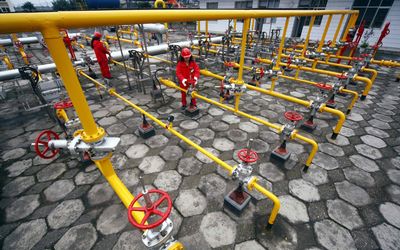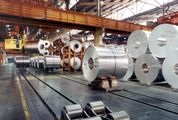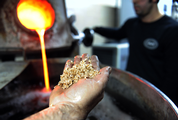NEWS ANALYSIS: China seems to be getting the pricing balance right for natural gas
by Clyde Russel,
2014-08-22 05:24:28.0
NEWS ANALYSIS: China seems to be getting the pricing balance right for natural gas
CHINA’s natural gas dilemma was illustrated by two recent announcements, the first a price increase and the second the closing of two gas-processing plants.
The developments show the tightrope Beijing is walking by increasing natural gas prices to a level where increased exploration, production and imports are viable, but not so much as to crimp demand.
Natural gas prices for bulk buyers and nonresidential users will be raised from September 1 by about 20% or 0.4 yuan ($0.065) a cubic metre, to a national average of 2.35 yuan a cubic metre.
The increase serves to keep reform of the sector on track by making natural gas prices more accurately reflect the cost of production, transport and storage. But on August 18, PetroChina, the nation’s largest oil and gas company, said it was shutting two inland gas liquefaction plants and reviewing its strategy to use liquefied natural gas (LNG) to fuel trucks and ships.
PetroChina unit Kunlun Energy Co has spent billions of dollars building small-scale LNG plants to tap marginal gas fields, mainly in the country’s west and north. These plants were planned to provide LNG as a replacement for diesel in powering trucks and river vessels, but the 33% rise in gas prices since 2013 has rendered them unprofitable by increasing feedstock costs.
While small in the overall scheme of natural-gas usage, Kunlun’s problems illustrate the challenges of raising natural gas prices while still trying to boost the use of the cleaner-burning fuel.
Pollution has become a major issue in China and natural gas is seen as the best alternative to burning coal for power generation, and also to diesel and fuel oil as a transport fuel.
A gas-fired power plant produces on average about half the carbon dioxide emissions of a coal plant. It emits less than a third of nitrogen oxides and a mere 1% of sulphur oxides.
Natural gas use has been rising in China, and accounted for 5% of primary energy consumption last year, up from 2% in 2000, said an August 20 report by consultants FGE. Though this is low compared to many developed nations, FGE forecasts that natural gas demand will grow by an average 7.5% a year to reach 8% of energy consumption by 2030.
This additional gas demand will be met by a combination of rising domestic output, mainly from shale, increased pipeline imports, mostly from Russia, and higher LNG imports.
But key to the growth of China’s natural gas demand will be pricing, and striking the balance between incentivising domestic output and imports, and disincentivising consumption through high prices. It looks like China is starting to get the balance correct.
The latest price hike takes the domestic price for bulk users to about $10.64 per million British thermal units (mmBtu), roughly on par with the current Asian spot price for LNG at $10.80 per mmBtu and the reported price of about $10 per mmBtu for the Russian pipeline deal. This situation may change over time, however, with spot LNG now at the lowest level since March 2011, and likely to rise with the coming seasonal demand of the northern winter.
There are hopes among LNG buyers that prices have moved structurally lower given the additional supply coming onstream in the next three years, led by the seven projects under construction in Australia and the likelihood of a further five being commissioned in the US.
But even if a viable long-term price of LNG is around $12-$13 per mmBtu, this still implies Chinese domestic prices have to rise about 20%-30%. Though the Russian pipeline deal, slated to begin in 2018, is attractively priced compared to LNG, the reported cost is for delivery at the Chinese border. Transporting the gas to major markets such as Beijing may add another $3-$4 per mmBtu.
If Chinese gas prices were raised to closer to $13 per mmBtu, and for all customers, including residential, it would mean pipeline and LNG supplies wouldn’t be loss-making and domestic producers would be incentivised.
So far, though, China’s efforts to ramp up shale gas production have largely disappointed, despite the country technically having the world’s largest reserves.
Higher prices may be just the spur that companies need to boost their exploration efforts, but it also seems that realism about shale’s prospects is setting in, with the government halving its target output to 30-billion cubic metres by 2020, according to an August 7 report.
Reuters

Workers carry out routine checks at a gas refinery in Suining, Sichuan province. Picture: REUTERS
CHINA’s natural gas dilemma was illustrated by two recent announcements, the first a price increase and the second the closing of two gas-processing plants.
The developments show the tightrope Beijing is walking by increasing natural gas prices to a level where increased exploration, production and imports are viable, but not so much as to crimp demand.
Natural gas prices for bulk buyers and nonresidential users will be raised from September 1 by about 20% or 0.4 yuan ($0.065) a cubic metre, to a national average of 2.35 yuan a cubic metre.
The increase serves to keep reform of the sector on track by making natural gas prices more accurately reflect the cost of production, transport and storage. But on August 18, PetroChina, the nation’s largest oil and gas company, said it was shutting two inland gas liquefaction plants and reviewing its strategy to use liquefied natural gas (LNG) to fuel trucks and ships.
PetroChina unit Kunlun Energy Co has spent billions of dollars building small-scale LNG plants to tap marginal gas fields, mainly in the country’s west and north. These plants were planned to provide LNG as a replacement for diesel in powering trucks and river vessels, but the 33% rise in gas prices since 2013 has rendered them unprofitable by increasing feedstock costs.
While small in the overall scheme of natural-gas usage, Kunlun’s problems illustrate the challenges of raising natural gas prices while still trying to boost the use of the cleaner-burning fuel.
Pollution has become a major issue in China and natural gas is seen as the best alternative to burning coal for power generation, and also to diesel and fuel oil as a transport fuel.
A gas-fired power plant produces on average about half the carbon dioxide emissions of a coal plant. It emits less than a third of nitrogen oxides and a mere 1% of sulphur oxides.
Natural gas use has been rising in China, and accounted for 5% of primary energy consumption last year, up from 2% in 2000, said an August 20 report by consultants FGE. Though this is low compared to many developed nations, FGE forecasts that natural gas demand will grow by an average 7.5% a year to reach 8% of energy consumption by 2030.
This additional gas demand will be met by a combination of rising domestic output, mainly from shale, increased pipeline imports, mostly from Russia, and higher LNG imports.
But key to the growth of China’s natural gas demand will be pricing, and striking the balance between incentivising domestic output and imports, and disincentivising consumption through high prices. It looks like China is starting to get the balance correct.
The latest price hike takes the domestic price for bulk users to about $10.64 per million British thermal units (mmBtu), roughly on par with the current Asian spot price for LNG at $10.80 per mmBtu and the reported price of about $10 per mmBtu for the Russian pipeline deal. This situation may change over time, however, with spot LNG now at the lowest level since March 2011, and likely to rise with the coming seasonal demand of the northern winter.
There are hopes among LNG buyers that prices have moved structurally lower given the additional supply coming onstream in the next three years, led by the seven projects under construction in Australia and the likelihood of a further five being commissioned in the US.
But even if a viable long-term price of LNG is around $12-$13 per mmBtu, this still implies Chinese domestic prices have to rise about 20%-30%. Though the Russian pipeline deal, slated to begin in 2018, is attractively priced compared to LNG, the reported cost is for delivery at the Chinese border. Transporting the gas to major markets such as Beijing may add another $3-$4 per mmBtu.
If Chinese gas prices were raised to closer to $13 per mmBtu, and for all customers, including residential, it would mean pipeline and LNG supplies wouldn’t be loss-making and domestic producers would be incentivised.
So far, though, China’s efforts to ramp up shale gas production have largely disappointed, despite the country technically having the world’s largest reserves.
Higher prices may be just the spur that companies need to boost their exploration efforts, but it also seems that realism about shale’s prospects is setting in, with the government halving its target output to 30-billion cubic metres by 2020, according to an August 7 report.
Reuters





















Change: 1.19%
Change: 1.36%
Change: 2.19%
Change: 1.49%
Change: -0.77%
Data supplied by Profile Data
Change: -0.19%
Change: 0.69%
Change: 1.19%
Change: 0.00%
Change: 0.44%
Data supplied by Profile Data
Change: 0.62%
Change: 0.61%
Change: 0.23%
Change: 0.52%
Change: 0.12%
Data supplied by Profile Data
Change: -0.21%
Change: -1.22%
Change: -0.69%
Change: -0.51%
Change: 0.07%
Data supplied by Profile Data